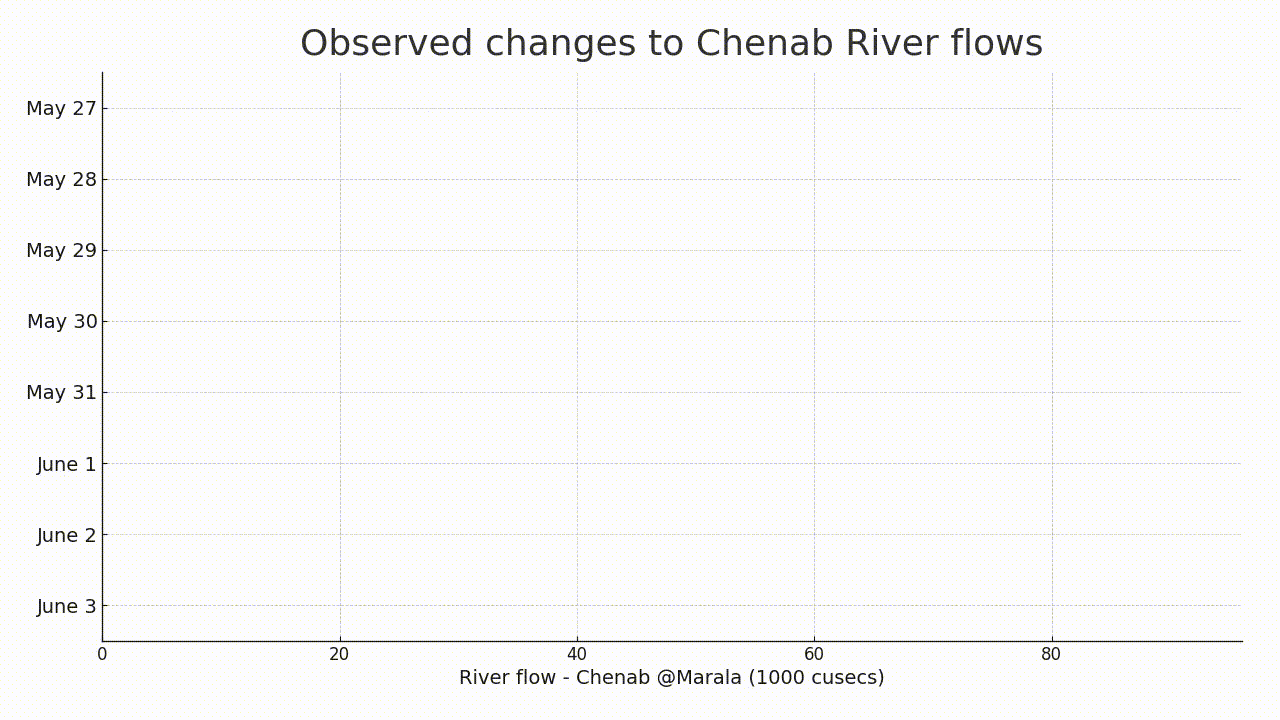On the morning of May 31, flow gauges on the Chenab River recorded an alarming decrease in the river flow. The development made headlines in the aftermath of the conflict between India and Pakistan, which broke out on May 7. As with a similar episode at the end of April, it led some to wonder anxiously: Can New Delhi shut Pakistan’s water supply just like that?
The bulk of Pakistan’s water supplies originate from three rivers — Indus, Jhelum, and Chenab — which are allocated under the 1960 Indus Waters Treaty (IWT). Two of these western rivers are buffered by large dams on the Pakistani side: Tarbela on the Indus and Mangla on the Jhelum. Each can absorb changes in flow with little effect on irrigation deliveries. The Chenab, however, is different.
Pakistan does not have a Tarbela-sized reservoir here, and upstream on the Chenab River, India operates three modest dams (Baglihar, Salal and Dulhasti). A closure at these structures can therefore look, at first glance, like the country’s tap has been turned off.
Here, we explain why and how the Chenab River flows can be disrupted (not blocked). Then we discuss what potential disruptions later in the year may look like. And, through this, we illustrate that while Pakistan must press its case against India’s illegal violations of the IWT, it also has room through smarter water management to blunt the impact of any Indian actions.
Pakistan’s vulnerability
Begin with the Indus River, which has an average annual flow of roughly 75 billion cubic metres (BCM) — enough to fill about 30 million Olympic-sized swimming pools. Two Indian run-of-river plants on the Indus River can together hold 0.02 BCM when their gates are closed — that is less than 0.03 per cent of the Indus’ annual flow, or only a few hours of discharge even in the low-water season. Once India’s small reservoirs fill, the water must spill onward, and the brief dent disappears inside normal reservoir operations downstream.
The situation on the Jhelum is similar. Mangla Dam on the Jhelum River sees about 27 BCM in an average year; Indian upstream infrastructure can store around 0.06 BCM, barely 0.2pc of the river’s flow. As things stand, and likely in the future, there is virtually no way India can cause any noticeable disruption to irrigation flows managed through the Indus and Jhelum rivers.
The Chenab, by contrast, reaches Marala with no Pakistani reservoir to cushion it. India’s infrastructure on the Chenab has a combined live storage — referred to as water that can be actively withheld or released — capacity of around 0.1 BCM.
This is where Pakistan’s water system is most vulnerable.
The Indian violations
Earlier in May, the Indus River System Authority (Irsa) reported an unusual change in average daily flows of Chenab as it entered Pakistan via Marala Barrage. As illustrated in the figure below, the seemingly normal daily average flows of around 50,000 cusecs recorded on May 27 and 28 abruptly increased over the next two days and then drastically decreased on May 31 and June 1, before returning to expected levels on June 2 and onwards.
The average river flows of Chenab can vary significantly at this time of the year due to a combination of glacial melt, rainfall and water management practices. However, day-to-day changes in flows typically do not exceed 5,000 cusecs, and even if they do, they are typically linked to precipitation or snowmelt upstream in the basin and can therefore be predicted.

Here, though, the disruptions in Chenab’s daily average flows reported between May 28 and June 2 were induced via upstream reservoir operations, as confirmed by subsequent reports.
The abrupt rise in flows on May 29 and 30 was due to reservoir flushing (emptying) by India on the same days — a process where accumulated sediments are removed from a reservoir by releasing water at high flow rates, which helps restore the reservoir’s storage capacity and improve water quality. It can also help prevent flooding by managing water levels and mitigating the risk of sediment buildup.
The reported live capacity of India’s reservoirs on Chenab is 0.1 BCM, which equates to around 21,000 cusecs of surplus average daily flow across two days. This aptly explains most of the abrupt rise in the river flow on May 29 and 30.
The reservoir flushing was followed by reservoir filling — when water is gradually filled in the reservoir up to its intended operating level — on May 31 and June 1 (see red bars in the above figure for illustration), coinciding with the sharp fall in flows at Marala. Once India’s facilities reached their capacity, the flow returned to normal from June 2 onwards. The total water that reached Pakistan during these five days (May 28-June 2) did not change or decrease; only the timing of it was affected.
The disruption in the flow of the Chenab River always heavily depends on the time of the year and strategies used by India for the flushing and filling of its reservoirs. The IWT has predefined rules for flushing and filling and its abeyance, which means that India could i) flush or fill its reservoirs at will, and ii) choose any strategy to maximise impact on Pakistan.
The figure below illustrates what a hypothetical worst-case scenario may look like in dry winter months (November to January), when average daily flows in Chenab can reduce to 7000 cusecs or lower.

This worst-case scenario in Chenab during this time could feature quick flushing (lasting two days) resulting in a huge relative surge in flows at Marala barrage, followed by slow filling (due to naturally low winter flows) resulting in reduction of flows at Marala to a trickle that could last for around a week (as opposed to the two day disruption observed in May). Again, it is worth reiterating that even in this worst-case scenario, the volume of water in Chenab will not reduce. Only its timing would be altered.
How to blunt Indian actions
Can Pakistan manage this level of disruption in flows in Chenab? Pakistani policy makers see the answer in concrete. Last month, the government confirmed it is studying a Rs220 billion Chenab Dam that would add storage on the Chenab. A reservoir of that size could cushion sudden draw-downs, but building a dam is expensive and will take many years. Pakistan cannot afford to wait that long or spend that much before acting.
Fortunately, the most effective countermeasures do not hinge on new megastructures. Real-time telemetry, flexible canal rotations, and coordinated reservoir operations can be deployed within a single irrigation season at a fraction of the cost.
These quicker fixes are not theoretical. Pakistan’s irrigation system is already highly engineered and interconnected. When Irsa noticed these Indian induced disturbances, it released water from the Mangla Dam to compensate for reduced flows on May 31 and June 1 and meet the demands of farms served by canals linked to both Chenab and Jhelum rivers. However, the reduction in flows was preceded by a surge as well.
Hence, if flow monitoring, operational allocation decisions at various government levels, for example, Irsa provincial irrigation departments, and canal gate operations are managed with synchrony, time efficiency and adaptiveness, disruptions in Chenab can be handled effectively. Pakistan’s water management and operation authorities need to be swift in determining the start of a disruption event and adapting operations accordingly. As demonstrated by the country’s effective military response to Indian aggression, preparation is half the battle.
India’s recent treaty violations (and those in the future) must be contested through diplomatic channels, but Pakistan’s most effective countermeasures lie in the country’s own hands. First, adaptive and coordinated water management using real-time telemetry can allow irrigation engineers to modify crop rotations and reservoir operations as soon as unusual flow patterns are detected.
Second, the 10-day warabandi schedule can be made elastic. Warabandi is a rotational water distribution system used on both sides of the water to ensure equal water access for farmers. It involves preparing a fixed schedule for allocating water to each farm, ensuring that every landholder receives a predetermined share of water based on their landholding size.
Allowing a “floating start”, in which the entire rotation slides forward when an upstream interruption occurs, preserves each farmer’s share over the full cycle even if one day is lost. The change is administrative, not infrastructural, yet it converts a sudden change into a manageable rescheduling exercise.
None of these steps requires new legislation or massive investment. By adopting them while pressing its treaty case, Pakistan demonstrates that measured, data-driven management is the strongest reply to hydraulic theatre.
Violations purely for show
Annual reservoir flushing is not new. Schedule E of the Indus Waters Treaty explicitly allows India to flush its reservoirs to purge sediment, provided two conditions are met: (i) Pakistan receives advance notice, and (ii) the drawdown is timed for seasons when the water flow is high and the impact downstream is low.
For years, this coordination worked. Indian dams were flushed in the high-flow season, briefly dipping Marala’s gauges. The surge of summer meltwater masked the loss, and canal operations scarcely noticed. This is what has changed since India decided to put the treaty in abeyance unilaterally.
Reservoir flushing in late spring yields India little more than routine silt removal, but doing it without notice and unscheduled turns a maintenance chore into a prime-time spectacle for its domestic audience.
Several Indian television channels framed May’s drawdown as proof that “Pakistan’s water tap can be shut at will”, echoing the same outlets that aired fabricated claims of the Karachi port being destroyed during the recent skirmish. The pattern is clear: limited hydraulic facts are stretched into psychological warfare for domestic ratings. Such behaviour is unbecoming of a state that seeks regional or global leadership.
Violating the Indus Waters Treaty for a little more sediment flushing undermines New Delhi’s credibility far more than it inconveniences Pakistan’s canals. It advertises a willingness to bend rules for symbolic gain while delivering no tangible advantage in irrigation or power.
The temptation to answer theatre with theatre should be resisted. Pakistani media and officials are on firmer ground when they treat the incident as what it is: a violation that disrupts Chenab’s flow for a few days (while the total volume of water stays the same). Understanding and reporting the full context (rather than the hype) denies the tactic its intended psychological payoff.
India’s unscheduled sediment flushes can disrupt canal timetables for a few days, but it does not and cannot strangle Pakistan’s water supply. That reality should guide every response. Islamabad is right to demand that treaty rules on notice and timing be honoured. Yet the most convincing diplomatic brief is one backed by domestic readiness: gauges that speak in real time and a rotation calendar flexible enough to absorb short shocks. By improving its readiness, Pakistan can undercut the psychological edge of future draw-downs and strengthen its standing in any future negotiations. Proactive planning, not alarmist rhetoric, is the surest way to keep the Chenab flowing.

